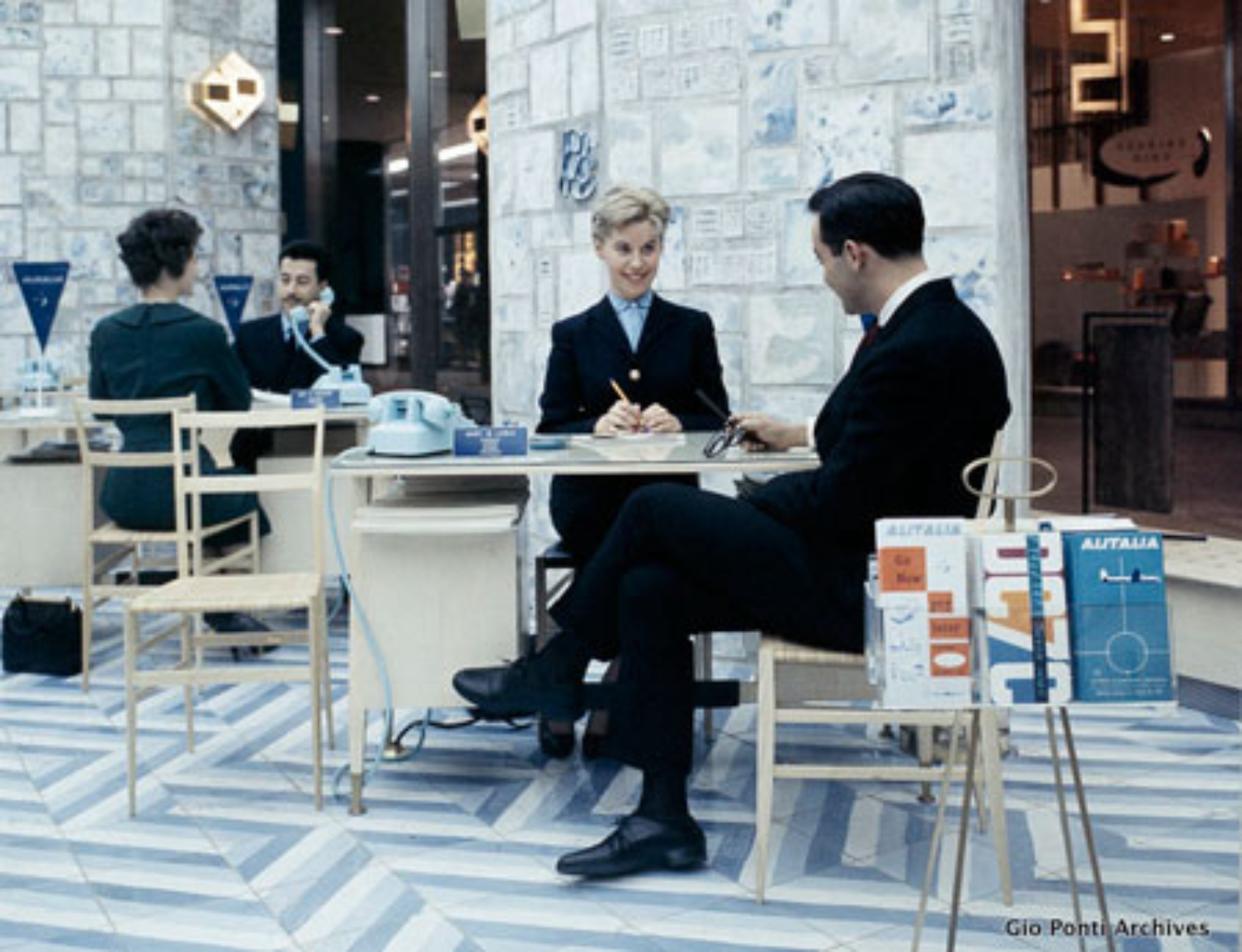 By Angelica Ponzio
By Angelica Ponzio As much as Gio Ponti was very meticulous and especially aware of the technical and functional aspects of his designs, he stands among his pairs by a kind of allure, an expression of fantasia, translated into color and texture. Moreover, that was definitely the impression that one can get by looking back at his American appearances in New York, in the late 50´s and early 60´s.
In November 1950, the Brooklyn Museum in New York and the Art Institute of Chicago organized a travelling show of decorative and industrial Italian arts entitled “Italy at Work: Her Renaissance in Design Today”. The show, which comprehended more than 2500 pieces, featured a sharper characteristic craftsmanship - what guaranteed, according to one of the curators, the architect or artist to express freely. Among the works on display there was a dining room from Gio Ponti, featuring a complete mechanized system with hidden pieces of furniture. With the collaboration of Fornasetti’s surface drawings, Ponti called attention to his overly decorated “invented furniture” in a game of surprises, by open and close mechanisms. He would write on Domus magazine about the show:
"The Americans, educated to the most direct functionalism, will be scandalized with this "dining room", which is created more to admire than to adopt. A symbolic room. This (…) is intended to be a presentation of some " Italian inventions” (Ponti, 1950).
Also in the 1950’s Ponti started to collaborate with two New York based furniture companies: Singer and Sons and Altamira. Looking to regain the decorative aspects lost on the contemporary functional furniture, they found in Ponti a very promising and productive collaborator. These brands displayed in shows and commercialized for over a decade some of the most inventive creations by Ponti. Between the pieces, there were Ponti´s version of the glass wall, the “furniture window” – combining shelves, light fixtures and frames to the window structure – and his “organized wall” – a panel that integrated many functions. Color was always present, suggesting a general composition to the whole space.
In the late 50´s, Ponti was invited to design in New York the interiors of the Alitalia offices on 5th Avenue and the Auditorium of the eighth floor of the Time Life building. In both cases, Ponti played with the spectator´s eye thru decoration – bidimensional surfaces evocated a tridimensional aspect thru materials, color and patterns. On the Alitalia offices, the use of ceramic tiles “decomposed” the wall planes and stressed the angles, which was also transposed to the geometric patterns of the floor. The light fixtures, also Ponti´s design, reinforced this aspect. White and blue were the predominant colors, with a touch of gold.[1] As for the Time Life building Auditorium, his beloved diamond shape pattern was present on the exterior ceramic covered walls and ceiling forming white, black and blue triangles – the same blue from the sky reflected on the façade of the tower. Again, Ponti used a pattern to dismiss the viewer’s eye: when seen from above it helped disintegrate the whole volume within the exterior floor surface. In the interiors, the golden yellow linoleum of the floor unified the whole space. There, the exterior diamond shape could be traced on some of the walls of the entrance hall, lit by indirect light, and in the opened pivotant doors of the auditorium, in a pontian game.
Ponti would never admit his work as belonging to a style or a school, as for him Italian design was never to be labeled. In an occasion of a show dedicated exclusively to him organized by the Boston Art Institute, he stated:
"Even today we talk abroad about the" Italian Line", but this “Italian line” does not exists: the Italians are the ones that in their simultaneous diversity constitute this Italian phenomenon. There isn´t that tenacious regularity and unity of taste, which identifies the Swedish or Danish, German or French productions. There isn´t an Italian taste, not a formal Italian standard; there are only the 'Italians" (Ponti, 1956).
Differently of some of his contemporaries and making use of ideas sometimes even excessive, Ponti’s work, without ceasing to be pragmatic, defended an inventive perspective, most of the time illusive to the eye, that would trigger our imagination: an expression of his true fantasia Italiana.
Footnotes:
Ponti, G. (1950). Una Sala da Pranzo da Guardare. Domus, 252, 28-29.
Ponti, G. (1964). Giochi con I Rivestimenti di Salerno, Domus, 414.
Ponti, G. L´Interesse Americano per L´Italia. (1954). Domus, 292, 56.
[1] Ponti would later state about this color predominance: "One of my tastes is to make all environments in one color. My house is yellow, the hotel in Sorrento is blue and another that opens in Rome is green" (Ponti, 1964).
Angelica Ponzio is an Adjunct Professor of Architecture at the Universidade Federal do Rio Grande do Sul, Porto Alegre, Brasil, since 1994, where she also received her Architectural degree in 1989. She holds a Master of Science in Advanced Architectural Design from GSAPP, Columbia University, New York (1991) and the title of Doctor in Architecture at PROPAR, UFRGS, Brasil (2013), for which she developed a research period at the Politecnico di Milano (INDACO, 2009) with a CAPES Brazilian scholarship. Her research interests include the interiors and furniture of Gio Ponti and its relationship to architecture.
